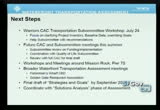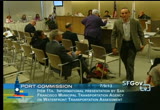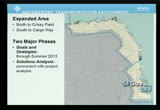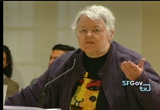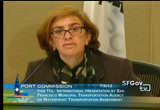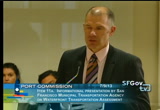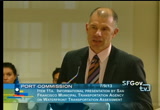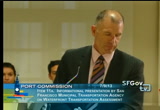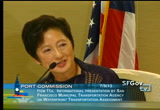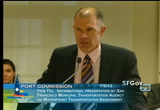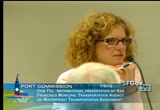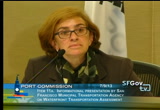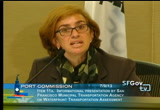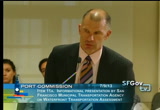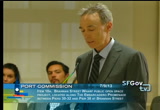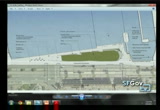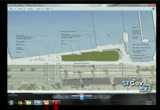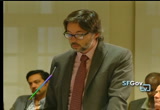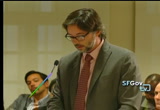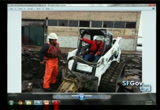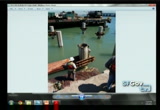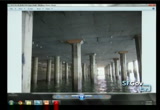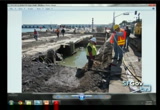tv [untitled] July 31, 2013 11:30pm-12:01am PDT
11:30 pm
parking and pedestrians all mesh together in the network so that is my milestone highlight for where we are. the document is available on our website and oeb .org and pier 32 website and diane has hosted the waterfront assessment on hers. it's a much longer document than the amount of time i spent with you today but i am sure you like to know it's there. it's the beginning of a conversation. you will hear and see me throughout the summer. >> thank you. is there any public comment? no. okay. >> the table was so far away. how do i use the light table? can i use the light table? >> yes, you may. just give us a
11:31 pm
second. >> just put up this map that he had. peter, would you put up this map page. >> actually ma'am he's going to help you so just a second. >> [inaudible] >> this right here. >> i have been dealing with planning issues since 1970, and i have been involved in all the plans that were rattled off by the planning director, and i listened really carefully to what peter said and what john said. john had one little sentence that i'm sure was thrown in because he kind of knows he should at least mentioning it and they will do things in the context of sea level rise, and it didn't come up at all. maybe i missed
11:32 pm
something as it flashing by. san francisco is republican denialists. you're the tea party. if we were in new york or reading the papers daily in new york and what they are planning -- right now the planning process as well as dealing with transportation because they found out they have a planning process and a siting of housing and a transportation system that is susceptible to climate events and ours are not going to be the same. we will not have a hurricane. we will have an earthquake and we will have sea level rise. the eastern boundary of the city is all fill. basically everything on this is fill. it's also
11:33 pm
marshes and they're the gigantic area south of market. again gi -- gigantic area around chinatown and bernal heights and that is where the new housing is going and where we're planning have new transportation. port commission and planning commission as well as staff should be digging down. we cannot let new york and new jersey leave us in the dust, but we are 3,000 miles away and that is what we're doing. there is an incredible amount of denialism about climate change in the extreme right of the republican party and i am sad to see it reflected in the reality of how we're dealing in san francisco. no one should be saying we are just immune to
11:34 pm
sea level rise, and the other problem that i see in this is that we are attempting to give over the eastern part of the city to extremely high income housing that is sold to people that don't have to live in the city and go around the world, and we have no civic consciousness about who we are as a city and who we are in the city have been historically a lot of lower income people and not hoaring after people that make $200,000 a year which is what we're doing now. thank you. >> thank you. is there any other public
11:35 pm
comment? commissioner comments? >> i want to thank you peter for the work that went into this and i know you touched on the issues near and dear to me and i emphasized last week i want to make sure we have improved bicycle safety and opportunities that will make a significant difference on so much of what we're trying to do. because it is such a significant issue i do want to just touch on the idea of climate change and perhaps we might not always talk about it here but i can't count the number of meetings i have sat in on projects and other efforts along the waterfront and talked about climate change and how to address it and that there will be a rise -- not if, but there will be a rise in sea level and looking at those numbers. give you an opportunity to perhaps touch on that and how we factored that into some of the plans. >> thank you and i want to
11:36 pm
point out that the work on the waterfront goes south of the what you saw on the map and i have worked with the hunter's point project and that completes the circuit. my experience on that and although i am transportation and one thing i understand and treasure island ear hunter's point or the projects here and. >> >> and the bulk head against sea level rise in the developments itself. i think that is the right strategy for the city. i certainly agree denial is a problem in the country and science shows sea level rise is inevitable and matching the land use and the infrastructure about with what is happening has been the marching orders of the teams i work with so if there is a specific interest in that i would like to come back with those staff that did the development and puc and how
11:37 pm
they're anticipating sea level rise in each of the projects moving forward. >> okay thank you. any other comments? i want to thank you peter for giving an update on the planning process and you are showing the dove tails from what we heard from john and i am just wondering because many of us go on embarcadero and others and we have experienced some of the larger events so are we going to be able to walk and chew gum at the same time and meaning can there be interim improvements because of the timeline you gave today we will have the assessment and the solutions and the solutions will take another year to analyze and dove tail into the eir process so we're talking about quite a while to get to some -- and there are things in the pipeline but are there any other tactical -- events that we can do and walking and chewing gum at
11:38 pm
the same time and for the improvement and some of the comments as people try to get one to end to another regardless whether it's america's cup or not are there improvements we could be doing while studying and figure out the longer term solutions as the projects are coming along and the longer term as well? >> yes president, yes and you're chewing gum and able to blow bubbles and we're seeing the bubbling up of ideas we're implementing this summer and for instance with the america's cup there are improvements that we started. i always like to link the america's cup planning with this assessment and there is no difference for the large event and what we need to do for the long haul. we are using these pilot projects how to run the e line service and see it running more because of the service from mission bay to the wharf and
11:39 pm
the bicycle lanes painted green is a brilliant idea and i checked it out and people are using the lanes in bigger numbers and no longer on the sidewalks. >> and they're stopping at the signals. that's the best part. >> that's the bubble blown and chewing gum. >> people are running in them and they're minding the traffic and i don't know about green compared to red. >> and i am proud of my colleagues and looking at these projects and something that is a quick fix and where we need to go for the long hall but if you look at the assessment you will see half dozen projects and we are implementing projects already that weren't on the radar screen six months ago. >> on that front and i think many of the commissioners know and monique knows and we heard earlier about the reaction to the bart strike and how we had to gear up the ferries so in
11:40 pm
terms of specific recommendations that we can do as far as more water transport and where do you think that will come in because there is planning involved here? -- and the port needs to do that and adding more fers in response to the bart strike and i want to make sure it's part of the plan and the east west we can deal with, but the north south i feel we are lacking at this point. >> thank you. i would agree. i'm sorry was there a question? >> no. i am saying specifically -- so when you come back again hopefully in a few months we can understand so -- i'm not sure given where you are and where everyone is with the port how we're coordinating the effort to make sure there is a strong
11:41 pm
water transport plan in place and everyone has a piece of it. >> thank you president woo ho and that coordination with the waterfront and golden gate ferry and part of the america's cup's response. if you saw how we handled it during the bart strike it was from coordination from a year ago. we are working with the designation of a special events team -- >> i'm not talking about events but making it part of the regular transport infrastructure for the port and not just games or special events. >> that's correct. what events is done and anytime there is an emergency situation and how we learn to ramp up transportation when we need it and going from a special events team and how we do it when there is extraordinary demand and the bark strike was an example of that and it wasn't a special event but a terrific response throughout the region and we
11:42 pm
learned what it takes to do that rather than just a as needed response. >> one thing and i don't know if it's impossible and is there a way to coordinate the lights on embarcadero so people feel like it's -- i mean it's a tactical thing and a lot of people feel they get -- there is nothing going on a given day and just people are stuck in traffic. >> director moyer asked me about the same thing about two months ago and i believe you got a response about that and was it folsom? >> yeah, we have looked at the timing here and improves the transit time but still needs more work but the question for you the signalization as you come on the embarcadero to the bay bridge and that works
11:43 pm
well but up on the bay bridge people are sneaking ahead of you and you second sit through six signal changes and they are coming back and definitely working on it and have something soon and all the way down to embarcadero. [inaudible] don't tell that. >> i am happy to come back to you and the question on signals and that will part of the presentation. >> thank you for taking the time. >> you weren't here and i guess one of the colleagues presented on some of the plans for transit particularly in light of the america's cup and the louie vuitton race and others throughout the summer but one of the issues concerns that i raised in addition to ensuring we have areas for the
11:44 pm
bicycles bidirectional which is my understanding that will be accomplished going forward now, but also what we're doing to ensure some better striping or what can be done to ensure safer movement from the cal train terminal where we anticipate people are bringing in their bicycles from train and getting them safe three along the waterfront and not start until washington street but seems we're missing an opportunity to experiment with the in flow of visitors at this time to improve bicycle safety and transit along that route and i don't know if there is a specific answer for that but plant that seed and question. >> in the audience we have [inaudible] from mta and they're work on the bigger bicycle project and we got a grant to
11:45 pm
design and engineer what would be that exact facility. the america's cup experiment really isn't the true test of that potential because that requires more substantial change toss the sidewalk. what we are learning though from the america's cup experience is the value of separating the bicycles and the pedestrians on the congested part of the embarcadero and that have been a success and i have seen success from simply of painting things green and a separate facility and north of washington and pier 27 and 29 and that is it where the pedestrian volumes are the thickest and giving bicycles space outside the sidewalk but not necessarily taking out the north -- all the northbound lanes in the embarcadero is one of the compromises and will roll out again in september. to go to the cal train station, if i can speak with approval of the group is part of the planning study. >> thank you. >> thank you very much for
11:46 pm
coming today and we look forward to your future updates. >> now we're going to item 10a. informational presentation and the wharf project located along the embarcadero promenade between piers 32 and 38 of brannan street. >> good afternoon president woo ho and commissioners. today it's my pleasure to present the open space project on the wharf. i am dan [inaudible] with the plan division and i will describe features. project and the project's engineer is talk about the project how it's
11:47 pm
proceeding. the wharf located on the embarcadero promenade is a new public space over the water and parallel to the embarcadero promenade. the wharf replaces piers 34 and 36 and a new public space defining the center of the neighborhood. for a bit of history in the year 2000 bcdc working with the port amended the area plan. changes made to this plan and the port's water front use plan removed the long standing 50% fill replacement rule which prevented redevelopment of the historic ports and sheds. with adoption of these projects projects as piers one and one and a half to five and the exploratorium were able to move forward and with that plan the port agreed to construct two public spaces along the waterfront, the plaza which is the new public space
11:48 pm
which will begin construction in november in front of the cruise terminal at pier 27 and the brannan street wharf and describes the projects in detail by sizes and uses and the port agreed to construct these spaces in a 20 year period. the port began working with bcdc staff and a 23 member citizen advisory committee and had workshops and meetings and concepts reviewed at the board and advisory committee three times concluding with the concept design on december 9, 2002 with the port commission approval on august 12, 2003. then in 2009 concept design was reviewed at meetings and the commission.
11:49 pm
brannan wharf is a new wharf parallel to the embarcadero promenade shown on the screen. at the end and extending for up to 800 feet and up to pier 38. the wharf includes several major components that originateed in the public design process and part of the bcdc permitting including a neighborhood green which consists 400 shape lawn that you see, a walk way and seating and structure and active interpretive structure that illustrates the tide in the bay. san francisco history and taking the shape of the pier in the original location on the south end of the project and inlay of track and interpretive exhibits and mostly flat and raised planter of 18-inches in height and surround by the sea wall.
11:50 pm
the openness is to orient them towards the bay and the neighborhood in embarcadero. the project addresses sea level rise for a very substantial -- 840 feet section of the waterfront by gently tilting up from the embarcadero promenade and 1 foot at the north end and 2 feet on the south end and concrete curb on the edge and another foot there and we pick up that sea level rise protection on this section. of course it doesn't address the neighboring piers but a substantial section that you see us doing on the public projects as well and it also protects the adjacent businesses, both across the street protecting those commercial interests. the wharf includes a 52-foot long interpretive exhibit featuring the history and importance of
11:51 pm
the site and in conclusion before i hand it over to steven brannan wharf is intended to be a fun and sustainable project and has unscripted activity and an open environment and playful and subtle ways and i hope you will see it next week and i won't go into detail now and the construction and the way materials were sources. steven will now describe the project a bit further. >> good afternoon commissioners, executive director, port staff and members of the public. i am steven real and the project manager and i am privileged to work on this exciting
11:52 pm
project. this is a $26 million project. includes $7 million for demolition of the condemned pier 36 which is a massive reinforced concrete pier structure. demolition of 900 linear feet of bulk wharf and $19 million project to construct the new 57,000 square feet state of the art public open space wharf replacing 9,000 square feet of embarcadero promenade strengthening 200 linear feet of sea wall and modifying another 700 feet. funding for the project. $18.5 million in port funds. $4.7 million in federal funds through the 2007 water resource and development act. 2.9 million dollars for the 2008 clean and safe neighborhood parks bound. and $100,000
11:53 pm
from a california coastal conservancy grant. the project delivery method we choose is the traditional design build. we have two distinct projects and the demolition and construction project. we started final design in early 2009. we selected windsor kelly joint venture after a competitive rfp and port engineering division served as the architect. wendy proctor i think is here today. wendy did a fantastic job. i think you all agree and allen gin served with her. complications we encountered. a section of the sea wall was compromised. a portion of the embarcadero was support the by a failing structure and seismic vulnerability of the entire
11:54 pm
waterfront where we expect several feet of lateral spreading from major earthquakes and spreading toward the bay but we overcome the hurdles and all new construction. we used at looking at using existing piles and we couldn't do it. this goods good -- this goes beyond the code and we have seismic instrumentation on the wharf this. is the first wharf in san francisco with this. we have dialos the disek and on the sea wall. this information after an earthquake this is transferred to the center for research and help
11:55 pm
us identify any damage to the wharf and as dan mentioned we are adjusting this by tilt tg up and the rail and with the 75 year design life we expect at the end of 75 years we will start to get some flooding in the area and so we design the structure to with stand those loads and we have the lawn that is raised up and with that i hope you had a chance to get out there and take a look at some of the construction. this has been an incredible construction project of the it's right on the waterfront. we kept it all open and i'm going to roll through some photos. this is pier 36. we started demolition back in march 2012. this is scott zacker. he's the guy that took it down, essentially his company and they did an amazing
11:56 pm
project. i never have seen a demolition project like this and huge cracking jobs. they did it from working on the deck and pulling this up and we expected to be a six month project and it happened in three and helped with the schedule. he's a happy man. we have the construction company come in and start driving piles in july. this is some of the equipment. it was all done from the water and all right along the embarcadero promenade so you see we have steel piles and concrete piles. that's a $20,000 pile, concrete pile or the steel pile and this is a concrete pile and 260 piles in total -- i don't know how that got in there.
11:57 pm
a little bit out of order. back to demolition. some more pile driving. the crew just had a great time out there. it's spectacular place to be. they're right there. we had no accidents at all and you can see it happening there and the america's cup was happening and pier 30/32 and the boats were right next to us and again a fun place to be. you can see the outline coming together and then the next step in wharf construction how do you pour all the concrete over the water? you fly in these and support for the piles. this is some of the false work going in. we
11:58 pm
actually have $1.4 million of faws work on this job. a lot of people said "are you building a timber wharf?" . we are not building a timber wharf and this is hold the weight of the concrete and you will see that. here is the rebar. that goes in next. we have 1.8 million dollars of reinforcing steel. that's what a modern reinforced wharf looks like. a bird can't get out. we also had rock protection over the shoreline and it got its first test in the winter waves. this is from underneath looking at some of the work and here is some of the completed deck, a nice smooth flat plate concrete deck.
11:59 pm
herring season. we worked through that. the fishermen were all around us. the sea lions were all around us and we had a couple of massive concrete pours in the evening where we worked all night. this was 1200 cubic yards pored and trucks worked all night wrong and no complaints from the neighbors. we got to see the bay bridge lights tested out, quite a sight to see on the waterfront. most of the waterfront was built around 1920-1930 and here we are doing it a again and we had a section we had to close up the embarcadero promenade and working around the clock to get that done in only three weeks.
12:00 am
knocked it down and finally to the top side, and we've got the sea walls that are cast in place concrete. we have finished concrete -- i don't know how that got -- waterproofing within the planter area. soil making its way -- and this is a special -- lava rock soil mix. we have shallow planted area so it has to drain very well. it is an engineered soil mix. some of the completed architectural concrete work. it would look like farming out there for a little while and here the shade structure being flown in and attached and the america's cup boats are back. more concrete, lots of concrete. coconuts. this is a coconut mixture that was placed on top of
64 Views
IN COLLECTIONS
SFGTV: San Francisco Government Television Television Archive
Television Archive  Television Archive News Search Service
Television Archive News Search Service 
Uploaded by TV Archive on

 Live Music Archive
Live Music Archive Librivox Free Audio
Librivox Free Audio Metropolitan Museum
Metropolitan Museum Cleveland Museum of Art
Cleveland Museum of Art Internet Arcade
Internet Arcade Console Living Room
Console Living Room Books to Borrow
Books to Borrow Open Library
Open Library TV News
TV News Understanding 9/11
Understanding 9/11